 The rendering of religious, cultural and historical heritage into public property, the development of a Jewish collection and exhibition hall
The rendering of religious, cultural and historical heritage into public property, the development of a Jewish collection and exhibition hall
 The rendering of religious, cultural and historical heritage into public property, the development of a Jewish collection and exhibition hall
The rendering of religious, cultural and historical heritage into public property, the development of a Jewish collection and exhibition hall
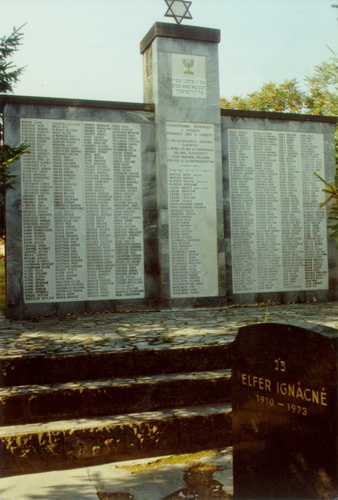 A short summary of the activities of the István Kertész Foundation -established in 1992.
A short summary of the activities of the István Kertész Foundation -established in 1992.
Hungarian cultural heritage is well-respected and prosperous, ranked high among the whole humanity. This comes from the fact, that the hungarian people are able to intagrate and also assimilate, and they were forced to remain in contact with a whole lot of different people, nation and culture. And one of these cultures, which lives in symbioses with the Hungarian, is the thousands of years old jewish culture.
One of the oldest and most significant jewish community in Hungary was the one in our town, until the middle of the 20th century. (According to the "Hungarian Jewish Lexicon by Péter Újvári which was released in 1929.)

(The synagogue of Balassagyarmat, one of the largests ortodox synagogues in Central Europe, which was able to welcome nearly 4000 believers. The building was nearly five storey high. It stood where the current market place was, until it was demolished on 9th December 1944 by the retreating German army.
If you want to read more about its construction or history, check out the link "Tanulmányok/Studies" and its sublink:
„A szerencsétlen csillagzatú ügy”- unfortunately at present only in Hungarian
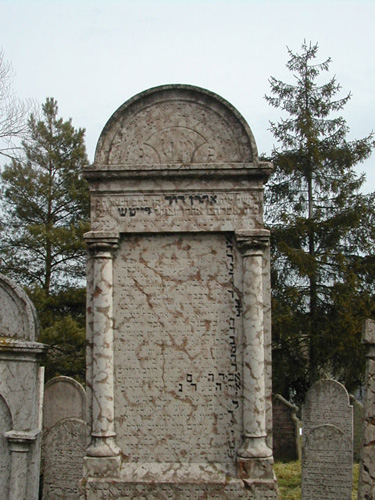
(Áron Dávid Deutsch /born: 1812 Raudnitz - died: + 1878 Balassagyarmat/ Tombstone of the famous Chief rabbi of Balassagyarmat at the local cemetery, Photographed by: István Kovalcsik , 2003.)
World War II and its destruction had its impact on our town too. Ever since the once prosperous community is only a shadow of its former self, but it still has a lot of value, for example the hundreds of years old orthodox cemetery, which was named to be a national art relic in 1993. It was the first among the hungarian jewish cemeteries, which gained this honor after the fall of the Communism in Hungary.

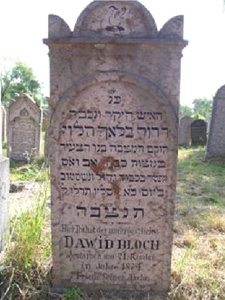
(A Cohanite and a Levite gravestone. Only two from the nearly 3500. Photographed by: István Kovalcsik , 2005.)
One of the main reasons why the Foundation in 1992 was established is to protect and take care of this historical value. It was founded by a local civilian person (István Kertész z'l), according to his own free will and from his own property. (If you want to read more about this- for the time being in Hungarian - please check out the link Tanulmányok and its sublink: Holocaust hatása és utóélete Balassagyarmaton.)
The following people were the members of the original advisory board: Lajos Bakos z'l, vice-president of the East-European Bureau of the Jewish World Congress, József Róth z'l, chairman of the Jewish community, Dr. György Németh, contemporary major of Balassagyarmat, and Béla Majdán historian, who is the secretary of the Foundation ever since.
The Foundation is not a religious, but a non-profit organization, its goal is to protect the above mentioned cultural heritage . Its owner is its advisory board, which has the towns actual major among its ranks. The majors were since now: Dr. György Németh, Péter Juhász, István Lombos and currently Lajos Medvácz .
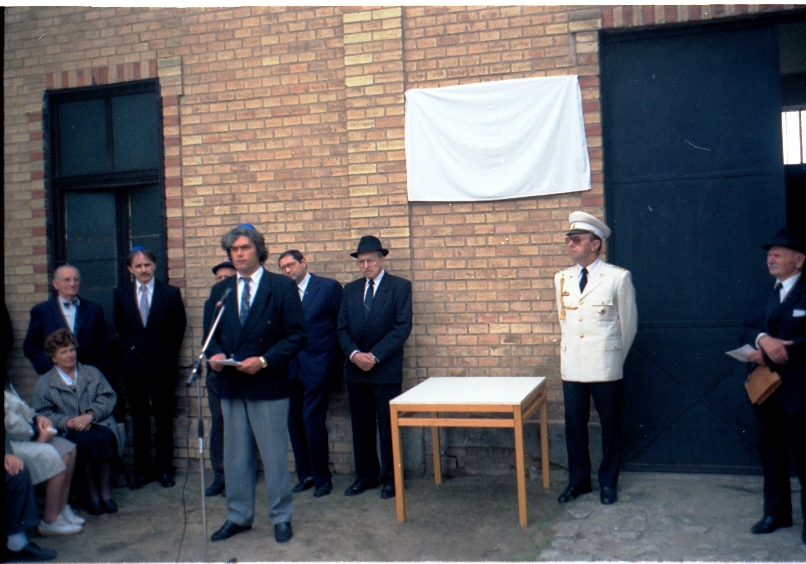
(Dr. György Németh major, Lajos Bakos z'l, vice president of the East-European bureau of the Jewish World Congress, Iván Beer, president of the Hungarian Holocaust Memorial Board, Col. János Réti, aide-de-camp of Árpád Göncz, President of Hungary and József Róth Chairman of the Jewish Community at the 50th annivarsary of the Holocaust. The first jewish cemetery declared a historic monument in Hungary. Photographed by: László Reiter)
The Foundation spent almost 2,5 million Forint (roughly 12600 USD) on renovating the building of the Chevra Kadisha (""holy society", burial organisation) which was built in 1913. After the renovation the Foundation opened an exhibition in the building in 2000. (Photographed by: László Reiter, 1997.)


Leslie Keller, President of the Easter-European Bureau of the World Jewish Congress (in the wheelchair), and Gusztáv Zoltai, executive director of MAZSIHISZ (Alliance of hungarian jewish faith communes), together with the major Juhász Péter in 2000. They opened the exhibition at the former tabernacle. Hungarian national television channels, MTV 1 and MTV 2, reported about it in their cultural magazine, edited by Gábor Matúz. (Photograhed by: Reiter László 2000.)

Crew of the Hungarian Television with József Róth z'l, Chairman of the jewish community, Gábor Matúz editor in chief, and Béla Majdán, historian, after the opening ceremony in 2000)

A fragment of the exhibition. (In the foreground you can see the Torah scroll (The five books of Moses) on the bimah (torah-reading table), in the background you can see the ark of the covenant. (Photographed by: István Kovalcsik, 2000)
Elements of the activities of the Foundation for protecting the cultural heritage:
continous protection and maintenance of the art-relic cemetery, photographing all the stones (appr. 3400) one-by one, scientific processing and translation; collecting historical documents; maintaining the permanent exhibition at the museum, publishing articles and books; prevention of xenophobia and racism, education for adults and students, providing services and informations for tourists; protecting and guarding, asset management, administration and accounting, preparing and applying for different tenders, etc...
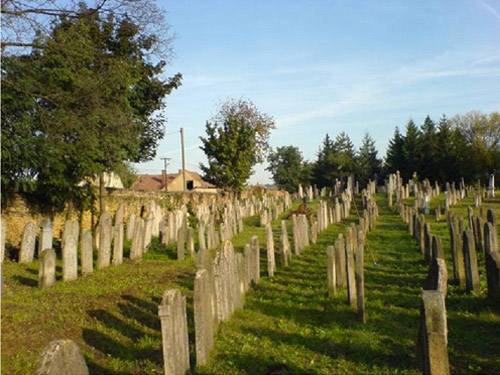
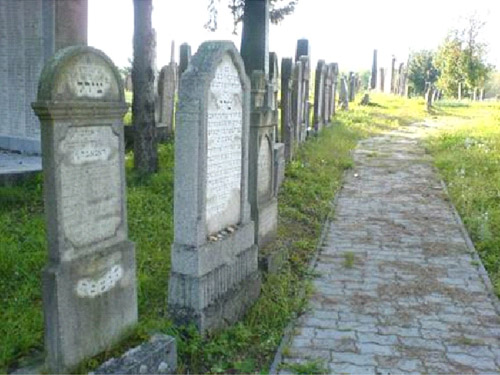
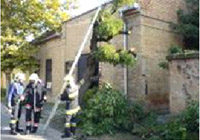
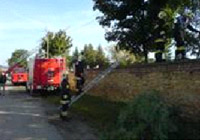

The Foundation and local Jewish Community try everything to keep the art relic cemetery in the best possible shape, and create a civilized, modern and exigent environment for those, who came to visit.
Some of the actual achievements of the Kertész István Foundation:
I. In connection with the art relic cemetery:
- In 2009 there were two cases of violance in the cemetery, by far-right perpetrators, who destroyed some of the stones in the graveyard. We had to assess the damage and make documents. Reconstruction has been finished in 2010 with the generous support of the Municipality of Balassagyarmat, MAZSIHISZ and several individuals. In parallel, as our tradition and spirituality dictates we doubled our effort to fight against racism and discrimination through the local and the national media.
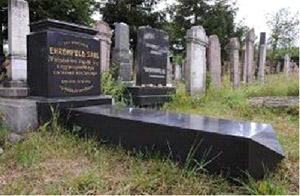


Interesting and sad fact, that Balassagyarmat never needed to face such things before. Not even when the nazis were in charge, and not during the communism. There was no case of violance against the jewish cemetery. But since 1990, the year when Hungary's political system changed back from communism to democracy, there were five cases of such acts, two of them in 2009. (Above you can see three of the damaged gravestones on the pictures. One of them belongs to Saul Ehrenfeld – who was the father of the world-famous Michel Gyarmathy, artistic director of the Folies Bergere in Paris. The other one was an old stone from the early XIX century. The photos were taken by the police.)
- We created a database, which contains all the (nearly) 3500 photos from the graves, with the available hungarian translations, the exact location of each gravestone, etc. This cemetery register will be available soon on DVD-ROM and its also printable, which is not a common thing among jewish cemeteries with this size.
- In this year, like always, we welcomed visitors from Hungary and from all over the world. We served the tourists all year long, often after workhours, and even sometimes on holidays. We held classes and served as tour-guides for adults and children alike.
- We also would like to mention here, that we also serve educational purposes. We held "unconvential history classes" at the tribute places of the "older brother of Cristianity" (Pope John Paul II), in the building of the Chevra Kadisha and in the orthodox cemetery for almost 500 primary and high school pupils yearly. In these classes we try to teach them about the city's jewish past, judaism, jewish customs and also about the Shoah.
We organize Holocaust education in Balassagyarmaton every year since 2002 on the National Holocaust Memorial Day. These memorial days had already thousands of children as visitors altogether.
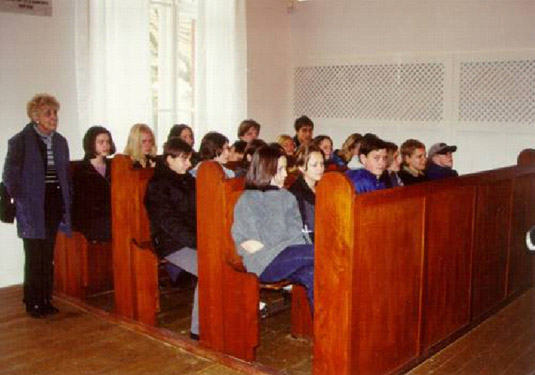
Mrs. János Marosi teacher of history and her class, from a local primary school, attending one of the above mentioned classes in the old tabernacle (Photographed by: László Reiter, 2002.)
- We take part at the Holocaust commemoration, which is organized by the Jewish Community, every year in June , where we pay tribute to the victims of the Shoah.
II. In connection with the exhibition:
- we welcome hungarian and foreign visitors continously from all over the world. Our exhibition became one of the most visited and most important touristical sights of the city during the past years.
- The exhibition expanded with further photos, documents throughout the years. Especially worth mentioning the letters we exchanged with the Memorial Museum of Hungarian Speaking Jewry which is located at the town of Safed in Israel. We also contacted the Holocaust Memorial and Documentary Centre in Budapest.
- March of the Living Hungary Foundation is organizing a "Wagon Exhibition" since 2007. In 2009 the exhibition has arrived to Balassagyarmat. It is basically a traveling exhibition, which helps to learn the facts in an era, when some people began to deny the Holocaust. The Kertész István Foundation helped to organize this event, and almost all of the students of the local high schools and elementary schools has participated in it. That means almost 2000 students. (Note: According to the registry of the organizers, this was one of the highest attendance in the whole country, and the opening ceremony was held by the Foundation, and the town's most important politicians and also the local clerical leaders participated in it, and they raised their voice against discrimination and hatred.)
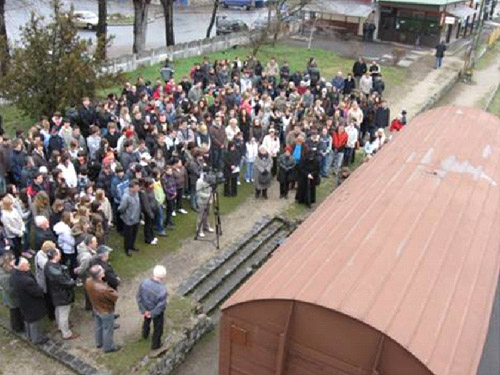
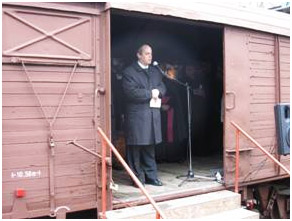
Rabbi Tamás Verő (Budapest)

Dr. Stella Leontin, Prebend of the Roman Catholic Church of Balassagyarmat

Zsigmond Molnár, Priest of the Reformed Church of Balassagyarmat. (Photographed by: Dékány Gábor, 2009.)
- We are planning to expand our exhibition with a new room. We have already started the constructional works, we hope that we will have the financial support needed to accomplish our plans.
- In 2009 we began to collect the famous artist's, Michel Gyarmathy's works, which are related to our town. We also try to get his former partners involved in this process.
- Numerous times we were asked for assistance from survivors and relatives -who visited us mostly from Budapest or foreign countries- to find their beloved ones, who are burried in our cemetery. We helped a lot of people get information, death or birth certifications, and other documents about their relatives.
- The Jewish Community and the Foundation has realised, if we want to build international relations, and we want to remain in contact with our visitors, we should create a webpage. We started it in the early months of 2010, and here you can see the result.
- As we already mentioned, we basically finished the map of the cemetery. We plan to publish a brochure and a book, which would greatly help to make the world notice about our art relic cemetery. We already contacted the Jewish Theological Seminary - University of Jewish Studies in Budapest we plan to publish them in 2011.
The Foundation managed to build up connections with people all around the world, and we try to expand this "social network" even further by joining to Facebook, and in other possible ways too. We are in a work relationship with the MAZSIHISZ (Hungarian Alliance of Jewish Faith Communes), and with the Municipality of Balassagyarmat. We are also succesfully aplying on the tender of the National Civil Fund in every year sice 2003.
Our most important partners and supporters are the following (you can click on the links):
- Memorial Museum of Hungarian Speaking Jewry
- March of the Living Hungary Foundation
- Holocaust Memorial and Documentary Centre
- Local high schools and elementary schools
- Local christian churches
- Urban Management Ltd. of Balassagyarmat
- Public company for Employment
- Local and national TV chanels and newspapers (Local TV, Nógrád Megyei Hírlap, Új Élet, etc.)
- Jewish Theological Seminary - University of Jewish Studies in Budapest
- The Hungarian Jewish Museum and The Hungarian Jewish Archives
- The Archives of County Nógrád
- National Archives of Hungary
- The local police headquarters
- the Bureau for Tourism in Szécsény
- Jewish Heritage of Hungary Public Endowment
etc..
18 years have passed since the Foundation was established, and we succeeded not only surviving, but we also were able to expand, and undertake new tasks. Nowadays we try to show this cultural, historical heritage to everyone, in its original surroundings, in an interactive fashion. We try to shape and educate the minds of the future, in hope of a better, more tolerant tomorrow. We also try to galvanize this area's tourism.

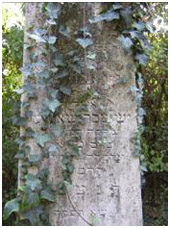

One of our goals - together with the local Jewish Community - to chart the abandoned jewish cemeteries in the surrounding villages in Hungary and in Slovakia and hopefully to restore them. (Above you can see fragments of the jewish graveyards of Bercel, Diósjenő and Szügy. Photographed by: Gábor Dékány, 2008)
We feel that our work is especially important these days, in a small town at the border of Slovakia and Hungary. Nowadays racism and intolerance is spreading once again, and we need to act and do all we can to stop it. We try to show a positive example, and show the past and hope people will learn from it. We feel this could help the fight for a better tomorrow, and maybe it will even manage to change our society's approach and attitude at least a bit, at least among our citizens. We are proud of our work, and we already grew out this little city. The Yad Vasem Institution in Israel, the embassy of the USA, the Cfati Museum all sent letters to us, in which letters they let us know they are pleased with our activities, we were on national television multiple times, the national TV MTV 1 and MTV 2 and Duna TV chanel (which is by the way available in the USA too) all praised and presented our Foundation, not to mention the numerous articles in almost every newspaper in the country.
Our Foundation is one of the rare foundations, which not only works since almost 20 years, maintains a well-known exhibition and a small museum, but also enhances the reputation of the City with the organisation of cultural and social events. In our Charity Evenings we invite famous and outstanding artists such Iván Markó, who was born here, and who brought the world famous Hungarian Festival Ballet to our stages (twice); composer and performer János Bródy was our guest too, just like Gábor Presser, the Budapest Klezmer Band, and the so called "Mikroszkóp Theatre" which featured some of the country's most respected humorists. When the Klezmer Band was here (2008. 11. 11.) we also remembered to the painter Ferenc Jánossy. It was, when we founded a Circle of friends for popularise the Foundation. More about this topic at this link: Circle of Friends of István Kertész Foundation) - in Hungarian only.
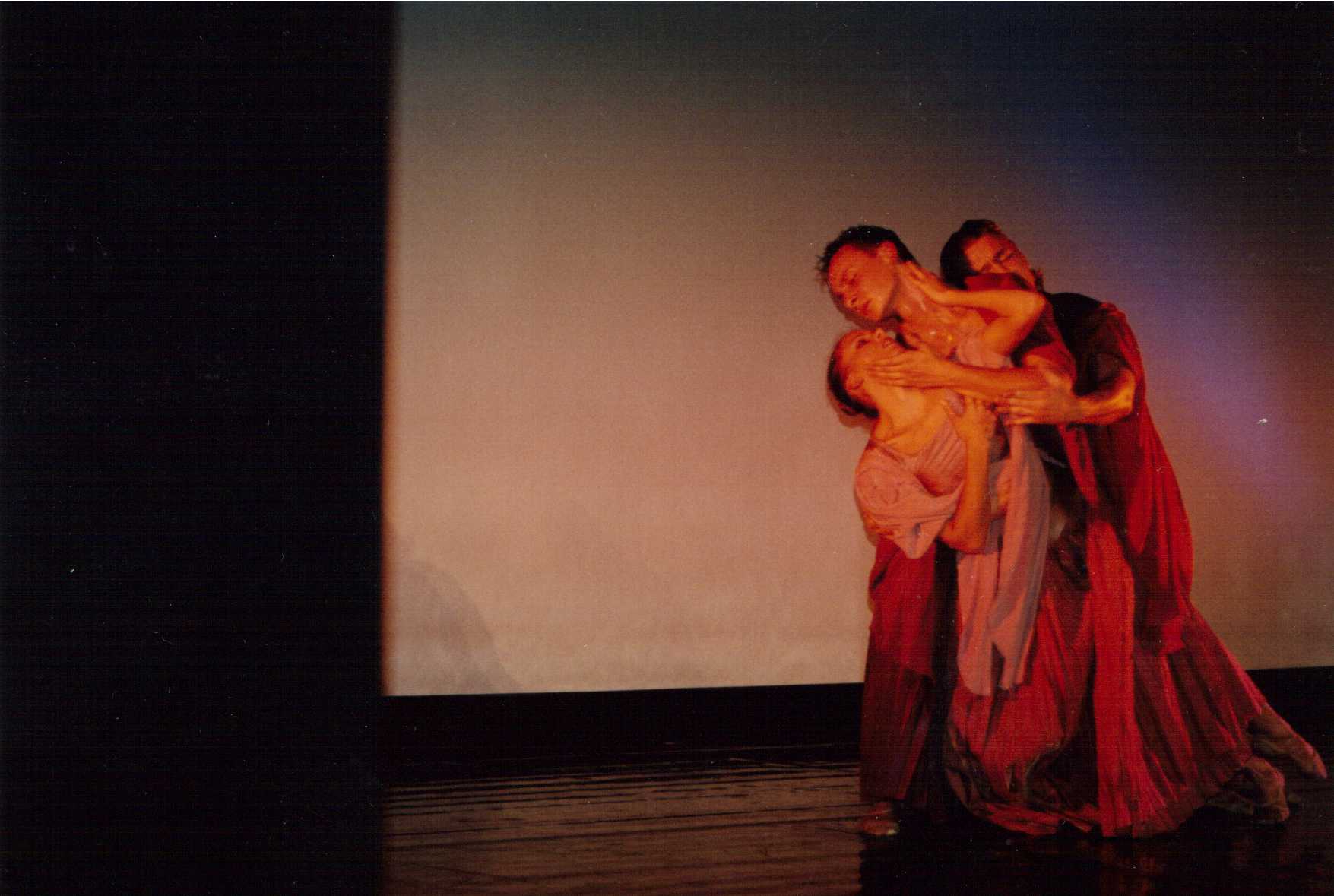

Iván Márkó accepted our invitation twice. He and the Hungarian Festival Ballet performed at the assembly hall of the city.

János Bródy in Balassagyarmat. His performance was a huge success. On this picture he is after the show receiving a specially prepared cake, which was baked by Jagyutt Péter confectioner. (Photographed by: Kiss Nelly, 2007.)
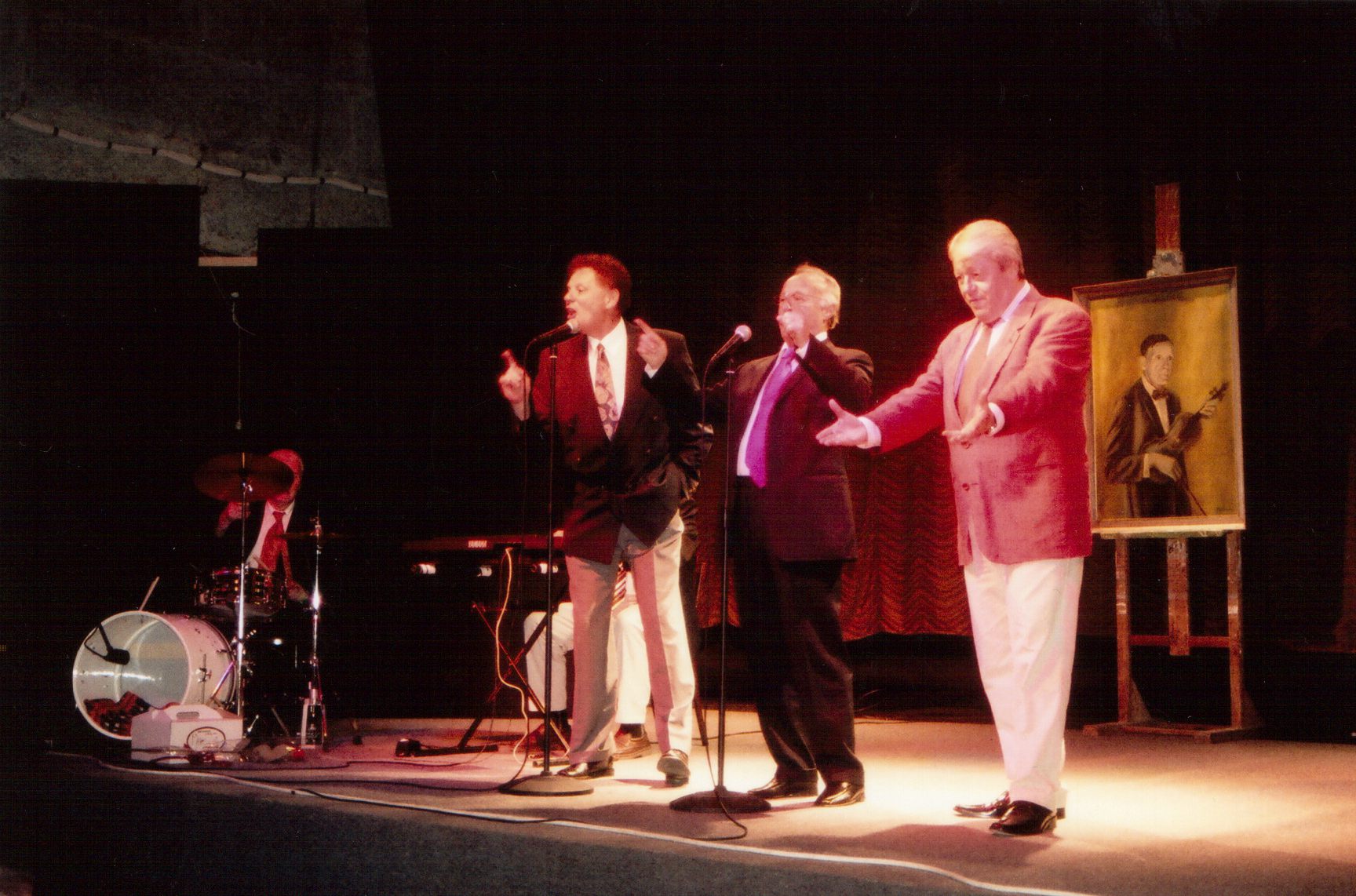
The so called Mini Microscope Theater (Beregi-Sas-Böröczki). They accepted our invitation in honor of Ernő Kondor (Kohn) ho was born in our city, and who was one of the founders of the hungarian cabaret. This event was called "The hungarian cabaret is 100 years old". The performance took place at the stage of the Madách Cinema (Photographed by: Gábor Dékány , 2007.)
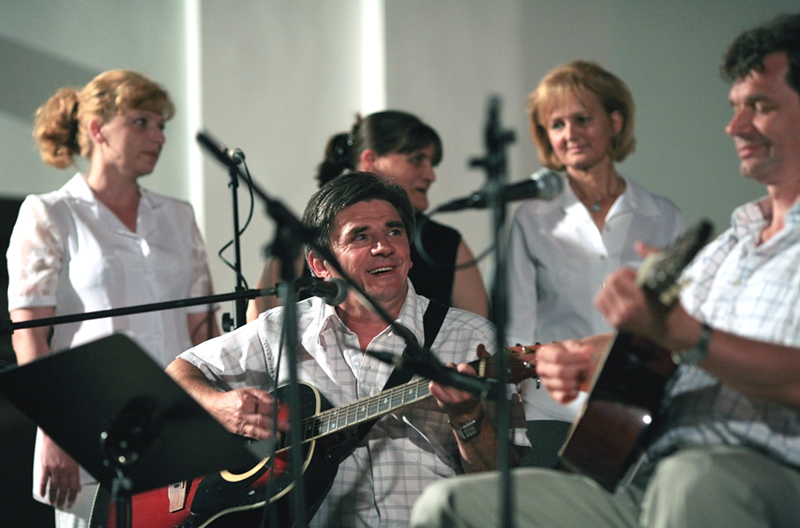
A picture taken, when Gábor Presser was greeted on his 60th birthday with his own songs after his performance. (The songs were singed by Sándor Kamarás ,
István Csábi, József Sinágel )
(Photographed by: Géza Pénzes , 2008. június)

Performance of the Budapest Klezmer Band
(Photographed by: Nelly Kiss 11.11.2008)
The István Kertész Foundation hereby expresses its graetful thanks toward the Municipality of the City of Balasagyarmat, members of the City Council, toward the MAZSIHISZ, and for those, who helped protecting and guarding the world famous jewish heritage of this town since the established of the Foundation in 1992.
With all the respect:
| József Bauer | Béla Majdán |
| president of the advisory board | secretary of the advisory board |
Translated by Majdán Béla Jr.